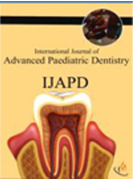Volume 4, Issue 1, 2019

Mcmed International
International Journal of Advanced Paediatric Dentistry
Issn
XXX-XXXX (Print),
XXXX-XXXX (Online)
Frequency
bi-annual
Email
editorijapd@mcmed.us
Journal Home page
http://mcmed.us/journal/ijapd
Recommend to
Purchase












